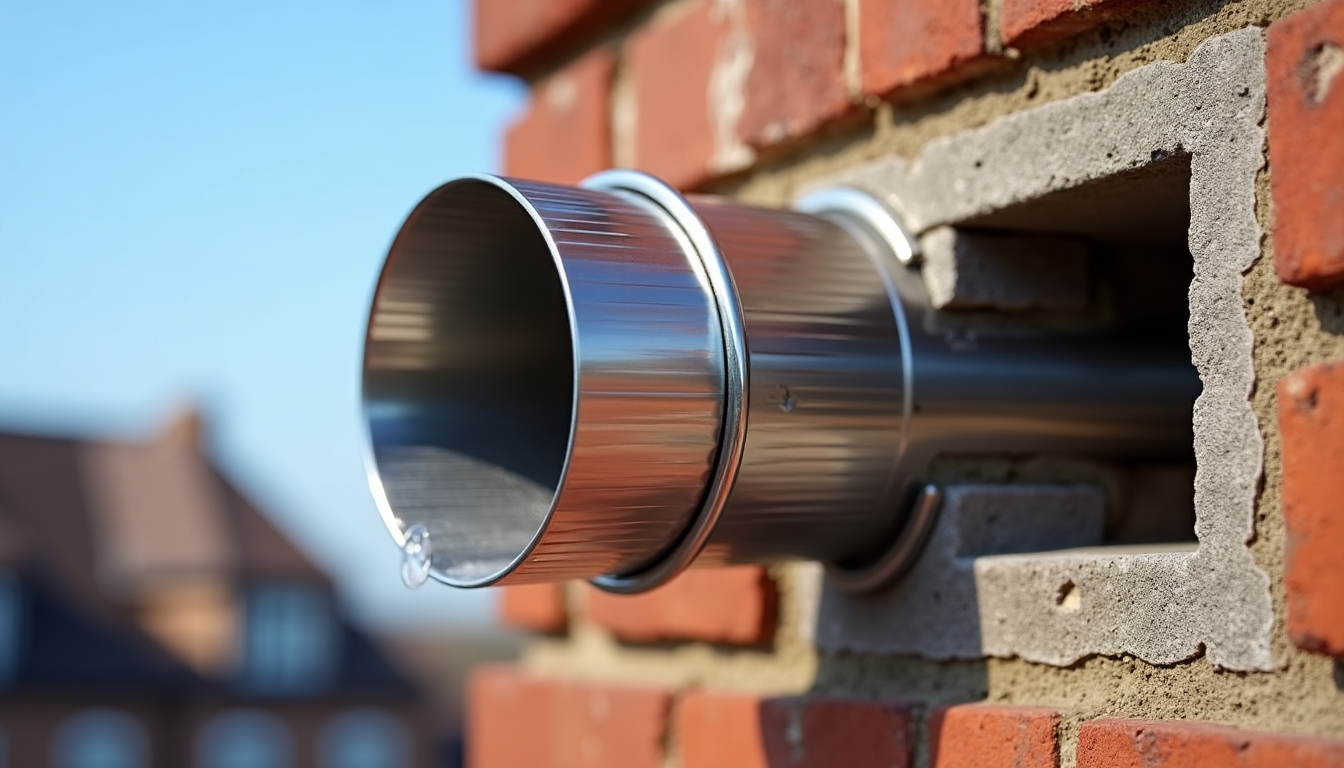Understanding 316L Smooth Chimney Liner: Benefits and Applications

The United States reports over 25,000 chimney fires each year. Poor maintenance and failing chimney liners cause most of these incidents.
A 316L smooth chimney liner provides excellent protection from these dangers and ensures your heating system works at its best. This specific liner grade excels in durability and fights corrosion effectively. These qualities make it the preferred choice in homes and businesses.
Choosing between stainless steel 316 vs 316L or looking at options like the 316ti chimney liner requires understanding their unique features. This piece gets into why more people choose the 316L stainless steel chimney liner. You’ll learn about installation methods, safety requirements, and upkeep needs. We’ll also see how it stacks up against the 316ti chimney liner in both performance and lifespan.
Let’s head over to the essential details you need to pick and maintain the perfect chimney liner that matches your requirements.
Understanding 316L Stainless Steel Properties
Let’s explore what makes 316L stainless steel perfect for chimney liner applications. This special grade has a unique chemical makeup that has:
- Chromium: 16-18%
- Nickel: 10-14%
- Molybdenum: 2-3%
- Carbon: Maximum 0.03%
Chemical Composition and Structure
Our 316L smooth chimney liner stands out because of its low carbon content. This prevents carbide precipitation during welding. This feature is vital to maintain structural integrity when temperatures run high. Adding molybdenum substantially improves the material’s performance in harsh environments.
Corrosion Resistance Features
Corrosion resistance plays a key role in chimney systems. The 316L grade shines here with superior protection against various corrosive elements. It resists water with chloride levels up to 1000mg/L effectively. This grade works exceptionally well against crevice and pitting corrosion in warm chloride conditions. These properties make it perfect for environments where moisture and combustion byproducts exist.
Temperature Tolerance Specifications
316L stainless steel handles temperature remarkably well. Tests show it resists oxidation in intermittent service up to 870°C and continuous service to 925°C. Best results come when operating within a melting range of 2500-2590°F (1371-1421°C). These specs make the 316L smooth chimney liner a great fit for wood, pellet, gas, oil, and coal-burning appliances.
The material’s 193 GPa elastic modulus boosts its strength and durability. This ensures the structure stays stable even in demanding chimney environments.
Installation Requirements and Guidelines
A successful 316L smooth chimney liner installation needs careful planning and precise execution. Let us show you the vital steps to complete this installation properly.
Pre-Installation Assessment
A full chimney inspection comes first. Our experience shows that exact measurements of the chimney flue’s inside dimensions are vital. You should look for damage signs, creosote buildup, and check existing liner conditions.
Tools and Materials Needed
You will need these vital items to complete the installation:
- Electric drill with flue brush attachment
- High-temperature silicone sealant
- Electric chipping hammer
- Safety equipment (gloves, goggles, dust mask)
- Mortar mix
- Stainless steel chimney liner
Step-by-Step Installation Process
- Preparation: Clean the chimney with an electric drill and flue brush attachment. A polypropylene chimney brush works better than metal brushes to protect the liner from damage.
- Liner Installation: Drop the 316L stainless steel liner down the chimney with its arrow pointing UP. Twisting the liner helps direct it through tight spots when you meet resistance.
- Securing Components: Apply high-temperature silicone sealant to the flue’s top edge. Place the top plate over the liner and secure it well. This top plate supports the chimney liner’s weight inside the flue.
- Final Connections: Join the liner to the appliance using proper adapters. Fireplace installations without an insert need an extra top plate where the liner meets the fireplace opening.
Proper insulation remains key throughout the installation. Premier Mix (poured insulation mixture) or Premier Wrap (ceramic wool blanket) creates steady draft and ensures zero clearance installation.
Safety Standards and Compliance
Safety standards are vital to the reliable performance of chimney liner systems. Let’s look at everything that makes 316L smooth chimney liners a trusted choice for safety-conscious installations.
UL Testing Requirements
Our 316L stainless steel chimney liners go through rigorous testing to meet Underwriters Laboratories (UL) standards. The UL1777 certification process reviews significant safety aspects. Our liners maintain a 1/2″ thick insulation to comply with UL1777 standards. This testing confirms consistent quality in materials and manufacturing standards.
Building Code Regulations
The International Building Code (IBC) establishes specific guidelines for chimney construction and liner installation. These requirements are the foundations of our work:
- Proper sizing to safely remove combustion byproducts
- Compliance with National Fire Protection Association (NFPA) 211 standards
- Adherence to International Mechanical Code (IMC) specifications for relining systems
Certification Requirements
Professional certification will give a proper installation and maintenance. Our installation process follows several safety protocols:
The core team complies strictly with OSHA standards for:
- Fall protection systems implementation
- Proper use of safety equipment and tools
- Personal Protective Equipment (PPE) requirements
Our 316L smooth chimney liners provide decades of safe and efficient service with proper installation that follows these standards. Regular inspections by certified professionals help maintain compliance with these safety standards.
Maintenance and Longevity
Proper maintenance of your 316L smooth chimney liner will give a longer lifespan and optimal performance. Regular upkeep extends your liner’s life and helps prevent dangerous situations.
Regular Inspection Protocol
Annual inspections play a crucial role in chimney liner safety. Professional inspections should include:
- Visual examination for cracks and gaps
- Assessment of creosote buildup
- Evaluation of connection points
- Check for water damage or corrosion
- Verification of proper draft
Cleaning Methods
Mechanical brushing remains the quickest way to clean 316L stainless steel liners. Chemical cleaners must be non-corrosive to maintain the liner’s integrity. The best results come from using fiberglass rods with a poly brush, as this combination thoroughly cleans without damaging the liner surface.
Signs of Wear and Replacement
316L stainless steel chimney liners typically last 25-30 years with proper maintenance. Several warning signs indicate potential problems that need attention:
Flaking debris in your firebox points to liner deterioration. Dark flakes of soot or creosote usually mean you need to clean the liner. Smoke or smoky odors in your home could indicate liner damage that needs immediate attention.
Your liner will last longer if you burn seasoned wood and avoid treated lumber or saltwater driftwood, as these materials can cause severe corrosion. Regular cleaning prevents creosote buildup, which helps maintain proper draft and prevents chimney fires.
Note that the 316L smooth chimney liner’s durability varies based on how you use and maintain it. Some lower-quality liners might need replacement in as little as five years. This highlights why high-grade materials and proper maintenance are essential.
Conclusion
Our research shows that 316L smooth chimney liners provide exceptional protection from common chimney hazards and last incredibly long. The liner’s chemical makeup includes low carbon content and added molybdenum that creates a strong defense against corrosion and high temperatures.
These liners can last 25-30 years when installed properly according to UL standards and building codes. You’ll need regular maintenance too. The material resists moisture, heat, and corrosive elements better than most alternatives. That makes it perfect for heating systems of all types, from wood-burning stoves to gas furnaces.
Quality 316L stainless steel chimney liners are affordable in the long run. Your chimney system can stay safe and work efficiently for decades with regular inspections, proper cleaning, and quick responses to warning signs.
Note that your chimney’s safety directly affects your home’s security and your family’s well-being. A well-installed and maintained 316L smooth chimney liner is a vital part of preventing thousands of chimney fires that happen each year across the United States.
FAQs
Q1. What makes 316L stainless steel an ideal choice for chimney liners?
316L stainless steel is ideal for chimney liners due to its low carbon content, which prevents structural issues during welding, and its high corrosion resistance. It can withstand high temperatures and aggressive environments, making it suitable for various heating appliances.
Q2. How often should a 316L smooth chimney liner be inspected?
Annual inspections are recommended for 316L smooth chimney liners. These inspections should include checking for cracks, gaps, creosote buildup, connection points, water damage, and proper draft to ensure optimal performance and safety.
Q3. What is the expected lifespan of a 316L stainless steel chimney liner?
With proper maintenance, a 316L stainless steel chimney liner typically lasts between 25 to 30 years. However, the actual lifespan can vary based on usage patterns and maintenance consistency.
Q4. How does a 316L chimney liner compare to a 316Ti liner?
While both are high-quality options, the 316Ti liner contains titanium, which provides slightly enhanced protection against high heat and corrosion compared to 316L. However, 316L still offers excellent performance for most applications at a similar cost.
Q5. What are the key steps in installing a 316L smooth chimney liner?
Key steps include conducting a thorough pre-installation assessment, cleaning the chimney, lowering the liner carefully, securing components with high-temperature sealant, and ensuring proper connections. It’s crucial to follow safety standards and use appropriate tools and materials throughout the process.

